A) $8, with 70 wagons produced in this country, 20 of which are exported.
B) $8, with 90 wagons produced in this country, 50 of which are exported.
C) $5, with 40 wagons produced in this country and another 30 wagons imported.
D) $5, with 40 wagons produced in this country and another 50 wagons imported.
Correct Answer

verified
Correct Answer
verified
Multiple Choice
Figure 9-5
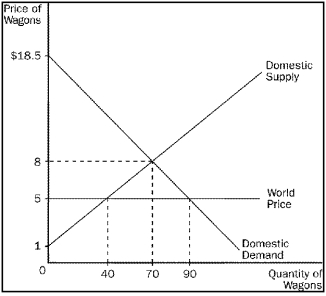 -Refer to Figure 9-5.Bearing in mind that this country is "small," what would happen if there were a decrease in the price of horses within this country,given that wagons and horses are complements?
-Refer to Figure 9-5.Bearing in mind that this country is "small," what would happen if there were a decrease in the price of horses within this country,given that wagons and horses are complements?
A) The quantity of wagons that this country imports would increase.
B) The quantity of wagons that this country imports would decrease, but the country would still be an importer of wagons.
C) This country would switch from being an importer of wagons to an exporter of wagons.
D) The domestic price without trade would move closer to the world price.
Correct Answer

verified
Correct Answer
verified
Multiple Choice
Figure 9-3. The domestic country is China.
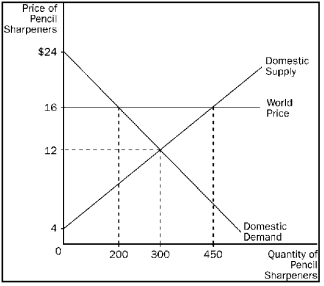 -Refer to Figure 9-3.The increase in total surplus in China when trade is allowed is
-Refer to Figure 9-3.The increase in total surplus in China when trade is allowed is
A) $400.
B) $500.
C) $600.
D) $750.
Correct Answer

verified
Correct Answer
verified
Multiple Choice
Which of the following is not an important question for economic policy raised by the experience of the textile industry?
A) How does international trade affect consumer well-being?
B) Who gains and who loses from free trade among countries?
C) How do the gains from trade compare to the losses?
D) Which argument for restricting free trade is politically feasible?
Correct Answer

verified
Correct Answer
verified
Multiple Choice
Figure 9-15
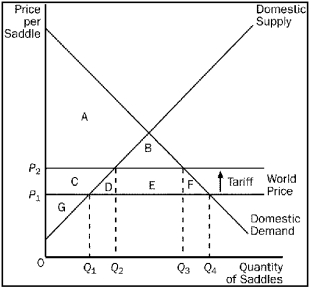 -Refer to Figure 9-15.Producer surplus with the tariff is
-Refer to Figure 9-15.Producer surplus with the tariff is
A) G.
B) C + G.
C) A + C + G.
D) A + B + C + G.
Correct Answer

verified
Correct Answer
verified
True/False
If the United Kingdom imports tea cups from other countries,then U.K.producers of tea cups are better off,and U.K.consumers of tea cups are worse off,as a result of trade.
Correct Answer

verified
Correct Answer
verified
Multiple Choice
A tariff on a product
A) is a direct quantitative restriction on the amount of a good that can be imported.
B) increases the domestic quantity supplied.
C) increases domestic consumer surplus.
D) All of the above are correct.
Correct Answer

verified
Correct Answer
verified
Multiple Choice
Which of the following statements is true?
A) Free trade benefits a country when it exports but harms it when it imports.
B) "Voluntary" limits on Canadian exports of hogs are better for the United States than U.S. tariffs placed on Canadian hog exports.
C) Tariffs and quotas differ in that tariffs work like a tax and therefore impose deadweight losses, whereas quotas do not impose deadweight losses.
D) Free trade benefits a country both when it exports and when it imports.
Correct Answer

verified
Correct Answer
verified
Multiple Choice
When a country abandons a no-trade policy,adopts a free-trade policy,and becomes an importer of a particular good,
A) consumer surplus increases and total surplus increases in the market for that good.
B) consumer surplus increases and total surplus decreases in the market for that good.
C) consumer surplus decreases and total surplus increases in the market for that good.
D) consumer surplus decreases and total surplus decreases in the market for that good.
Correct Answer

verified
Correct Answer
verified
Multiple Choice
Figure 9-6
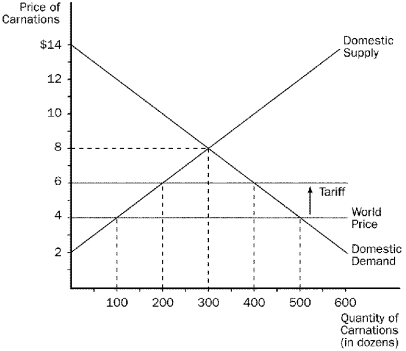 -Refer to Figure 9-6.With trade and without a tariff,
-Refer to Figure 9-6.With trade and without a tariff,
A) the domestic price is equal to the world price.
B) carnations are sold at $8 in this market.
C) there is a shortage of 400 carnations in this market.
D) this country imports 200 carnations.
Correct Answer

verified
Correct Answer
verified
Multiple Choice
Trade among nations is ultimately based on
A) absolute advantage.
B) strategic advantage.
C) comparative advantage.
D) technical advantage.
Correct Answer

verified
Correct Answer
verified
Multiple Choice
Figure 9-15
 -Refer to Figure 9-15.With trade and without a tariff,the price and domestic quantity demanded are
-Refer to Figure 9-15.With trade and without a tariff,the price and domestic quantity demanded are
A) P1 and Q1.
B) P1 and Q4.
C) P2 and Q2.
D) P2 and Q3.
Correct Answer

verified
Correct Answer
verified
Multiple Choice
In a December 2007 New York Times column Paul Krugman argued in favor of
A) protectionism based on the national-security argument.
B) protectionism based on the infant-industry argument.
C) protectionism based on the unfair-competition argument.
D) keeping world markets relatively open.
Correct Answer

verified
Correct Answer
verified
Multiple Choice
The nation of Aquilonia has decided to end its policy of not trading with the rest of the world.When it ends its trade restrictions,it discovers that it is importing rice,exporting steel,and neither importing nor exporting TVs.We can conclude that producer surplus in Aquilonia is now
A) higher in the steel market, lower in the rice market, and unchanged in the TV market.
B) higher in the rice and steel markets, and unchanged in the TV market.
C) lower in the rice and TV markets, and higher in the steel market.
D) lower in the rice and steel markets, and the same in the TV market.
Correct Answer

verified
Correct Answer
verified
True/False
The nation of Cranolia used to prohibit international trade,but now trade is allowed,and Cranolia is exporting furniture.Relative to the previous no-trade situation,buyers of furniture in Cranolia are now better off.
Correct Answer

verified
Correct Answer
verified
Multiple Choice
Suppose Iran imposes a tariff on lumber.For the tariff to have any effect,it must be the case that
A) Iran is an exporter of lumber.
B) the domestic quantity of lumber supplied exceeds the domestic quantity of lumber demanded at the world price without the tariff.
C) the world price without the tariff is less than the price of lumber without trade.
D) the world price without the tariff is greater than the price of lumber without trade.
Correct Answer

verified
Correct Answer
verified
Multiple Choice
After a country goes from disallowing trade in coffee with other countries to allowing trade in coffee with other countries,
A) the domestic price of coffee will be greater than the world price of coffee.
B) the domestic price of coffee will be lower than the world price of coffee.
C) the domestic price of coffee will equal the world price of coffee.
D) The world price of coffee does not matter; the domestic price of coffee prevails.
Correct Answer

verified
Correct Answer
verified
Multiple Choice
Figure 9-2
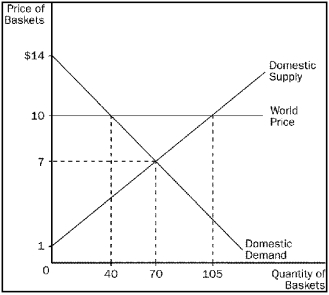 -Refer to Figure 9-2.As a result of trade,total surplus increases by
-Refer to Figure 9-2.As a result of trade,total surplus increases by
A) $80.
B) $97.50.
C) $162.50.
D) $495.50.
Correct Answer

verified
Correct Answer
verified
Multiple Choice
Figure 9-13
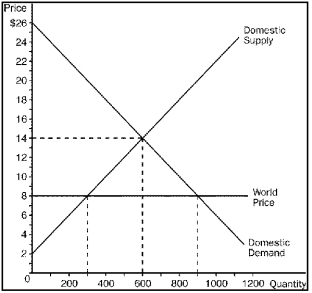 -Refer to Figure 9-13.With trade,producer surplus is
-Refer to Figure 9-13.With trade,producer surplus is
A) $900.
B) $1,100.
C) $1,500.
D) $2,000.
Correct Answer

verified
Correct Answer
verified
Multiple Choice
When a country abandons a no-trade policy,adopts a free-trade policy,and becomes an importer of a particular good,
A) producer surplus increases and total surplus increases in the market for that good.
B) producer surplus increases and total surplus decreases in the market for that good.
C) producer surplus decreases and total surplus increases in the market for that good.
D) producer surplus decreases and total surplus decreases in the market for that good.
Correct Answer

verified
Correct Answer
verified
Showing 181 - 200 of 410
Related Exams